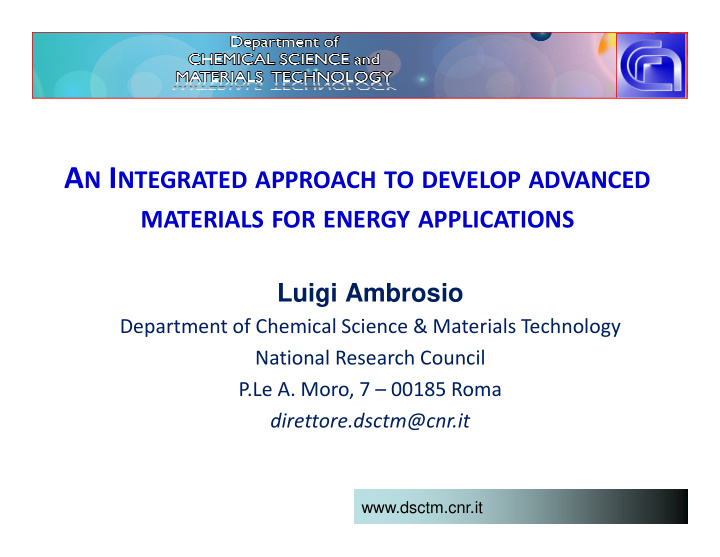



A N I NTEGRATED APPROACH TO DEVELOP ADVANCED MATERIALS FOR ENERGY APPLICATIONS Luigi Ambrosio Department of Chemical Science & Materials Technology National Research Council P.Le A. Moro, 7 – 00185 Roma direttore.dsctm@cnr.it www.dsctm.cnr.it
MATERIALS FOR ENERGY TECHNOLOGIES Photovoltaic Wind energy Coal plant Mature and innovative technologies are enabled by incorporating engineered materials into devices for high-efficiency, low-cost energy conversion and storage. Geothermal energy Battery &Electricity storage CSP&Thermal storage Nuclear energy Thermoelectricity
MATERIALS FOR ENERGY TECHNOLOGIES Solar Fuels by Artificial Photosynthesis Lighting (OLEDs, Solar Electricity Multifunctional and bio-inspired LECs) (OPV, DSSC, LSC) materials architectures (hierarchical), through interdisciplinary, offer major innovation and improvements in all energy technologies. 2nd Generation Biofuels CO 2 Separation and Capture Fuel Cells
ADVANCED MATERIALS FOR HIGH ENERGY EFFICIENCY • Multi scale polymer nano-composite µm nm mm SOLUTIONS SINGLE SHEETS BULK MATERIALS • Graphene based materials 1 0 0 µ 1 0 0 µ 1 0 0 µ 1 0 0 µ 1 0 0 µ 1 0 0 µ µ m µ µ µ µ m µ m µ µ µ µ µ m µ µ µ m µ µ µ m µ • Lightweight composite structures • Metallic foams • Ceramic hybrid systems • Silk fibroin in optoelectronics devices: silk silk diffracted orders diffracted orders Transistors & light emitting transistors grating grating
ENERGY CRITICAL ELEMENTS ECEs Energy critical elements There are two reasons for these critical elements to become scarce. Some, like tellurium, are simply not that abundant anywhere in the earth’s crust, whereas others are found only in a few places, which might create political issues for their supply. China’s dominance over Rare Earth Elements falls into that category, or Bolivia’s and Chile’s vast resources of lithium, which is used for rechargeable batteries. And the known global reserves of niobium, which is abundant and used for steels and other alloys, are almost entirely located in Brazil.
SUBSTITUTION OF ENERGY CRITICAL ELEMENTS Application Subcatagory ECE Substitute � � � � Electrics Batteries Cobalt Iron, organic polymers, manganese Graphite Silicon (nano) Lanthanum Zinc-air, lithium-air, aluminium-air, super- capacitors Silver, biocatalysts Fuel cells Platinum Electronics Semiconductors, Gallium ZnO/MgS, organic polymers, zinc, tin LED, OLED, photovoltaics Indium Organic polymers, graphene, carbon (ITO) nontubes, ZnO with metal grids Materials Catalysts Platinum Nickel, iron, biocatalysts Tungsten Iron oxide Metals, alloys Cobalt Nickel, carbides, nitrides, chromium, boron, titanium Tungsten Silicon carbide, molybdenum
KEY ENABLING TECHNOLOGY To foster the industrial deployment of European KETs In 2009, European Member States and the European Commission identified Key Enabling Technologies (KETs) for their potential impact in strengthening Europe's industrial and innovation capacity” Six KETs � Nanotechnology � Micro and nano-electronics � Advanced materials � Photonics � Industrial biotechnology � Advanced manufacturing systems High Level Group, Feb. 2013
KEY ENABLING TECHNOLOGY: INTEGRATION Europe's need for Energy is predicted to increase steadily, with most energy uses switching to electrical (transportation, heating, cooling). Electric energy production, distribution, storage and a more efficient use of electricity are striking examples where the application of KETs can provide powerful solutions for improving the future Energy System. ……..multidisciplinary and trans- sectorial, cutting across many technology areas with a trend towards convergence, technology integration and the potential to induce structural change to improve the industry competitiveness. http://ec.europa.eu/enterprise/sectors/ict/files/kets/hlg_report_final_en.pdf
INTEGRATION TO DEVELOP ADVANCED PRODUCTS & KNOWLEDGE INNOVATION INDUSTRY CONSORTIA DISTRICTS CLUSTERS RESEARCH CENTRES & UNIVERSITIES RESEARCH Exploit the scope of relevant R&D which support the full and simultaneous implementation the innovation chain, from basic research, through technological research, product development and prototyping up to globally competitive manufacturing.
CONCLUSIONS • Materials Science is one of the driving forces of innovation with significant impact on all strategic energy sectors; • Materials are fundamental for Energy and their cross-cutting aspects. •The Materials Science plays a central role in finding innovative solutions to major societal challenges; • Key Enabling Technologies approach & integration will foster European Industrial Renaissance (COM (2014) 14/2)
Recommend
More recommend